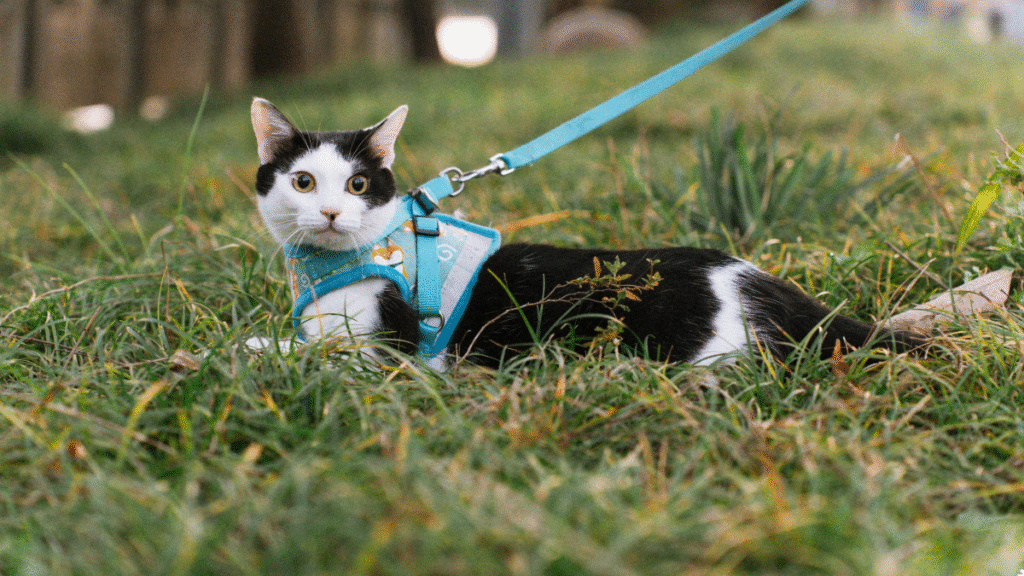Have you ever seen a cat walking calmly and obediently beside its owner on a leash? If so, you probably wondered how in the world they managed to do that. Cats are notoriously independent and strong-willed animals, and it often seems impossible to teach them anything.
Well, it turns out that cats can be leash-trained — although it requires time, patience, and consistency on your part. Training your cat to walk on a leash has many benefits, including enrichment, exercise, and safe outdoor exploration. In this step-by-step guide, we’ll show you exactly how to leash train your cat — from getting the right equipment to dealing with common challenges that may arise.

Why Should You Train Your Cat to Walk on a Leash?
Cats are naturally curious creatures. In the wild, they spend their days roaming, sniffing, climbing, scratching, chasing, and observing. Indoor cats, on the other hand, often lead more sedentary lives with limited opportunities for mental and physical stimulation. Here are some of the top benefits of walking your cat on a leash:
-
Mental and Physical Enrichment – Outdoor time allows your cat to experience new sights, smells, sounds, and textures that keep their mind engaged.
-
Exercise – Regular leash walks give indoor cats the physical activity they need to stay healthy.
-
Safe Outdoor Experience – Letting your cat explore the outdoors from the safety of a leash is ideal for curious felines.
-
Bonding – Spending time together during walks helps build trust and strengthen your connection.
-
Reduced Boredom and Misbehavior – A tired cat is a happy cat! Exercise and stimulation can reduce stress, anxiety, and unwanted behaviors like scratching furniture, aggression, or nighttime howling.
Step 1: Select the Right Equipment
Before heading outside, make sure you have the proper equipment for your cat. Cats require specific walking accessories, and it’s best to invest in high-quality items designed especially for them. You’ll need:
-
A cat harness (not a collar)
-
A lightweight leash
-
A cat backpack or carrier (optional)
-
Cat toys or treats for motivation
Important: Never attach a leash directly to your cat’s collar. Cats can easily slip out or injure their necks. Always use a harness with leash attachments. Cat harnesses generally come in two styles:
-
H-style harness – Lightweight and adjustable; great for calm cats.
-
Vest-style harness – Offers more coverage and security; ideal for escape artists or anxious cats.
Features to look for:
-
A snug but comfortable fit (you should be able to fit one finger between the harness and your cat’s body).
-
Adjustable straps for a secure hold.
-
Breathable materials like mesh.
-
Easy-to-use buckles or Velcro fastenings.
Leash Tip:
Choose a lightweight leash no thicker than your thumb. A retractable leash may seem convenient, but it’s often too heavy for cats and difficult to control. A regular, lightweight leash provides better safety and control.
Cat Backpack or Carrier:
A carrier or cat backpack is optional but highly recommended in case your cat panics outside. It provides a safe retreat.
Toys and Treats:
Bring a few of your cat’s favorite toys or treats to grab their attention and reward good behavior during the walk.

Step 2: Get Your Cat Used to a Harness Indoors
The first step is to help your cat get comfortable wearing a harness indoors before venturing outside. Cats dislike unfamiliar sensations, so putting a harness on too soon can cause fear or stress.
The goal is to make your cat love the harness — or at least tolerate it happily.
2.1. Allow Your Cat to Sniff and Explore the Harness
Place the harness near your cat’s favorite lounging spots. Let them sniff, rub against it, and explore it freely until it no longer feels like a new or threatening object.
2.2. Create Positive Associations
Each time your cat interacts calmly with the harness, reward them with treats and gentle praise. Positive reinforcement helps your cat associate the harness with pleasant experiences.
2.3. Short Harness Sessions
Once your cat is comfortable, gently put the harness on (without fastening it at first). Give treats, and let them wear it loosely for a few minutes. Gradually increase the duration as your cat adjusts.
Repeat these short sessions several times a day until your cat moves comfortably while wearing the harness.
Step 3: Practice Walking Indoors with a Leash
When your cat is relaxed in the harness, attach the leash and let it drag behind them so they can get used to the sensation. Once they seem comfortable, gently pick up the leash and follow your cat’s lead as they explore your home.
Let your cat go wherever they want and move at their own pace. Avoid pulling, tugging, or trying to direct them — cats don’t respond to leash pressure like dogs do.
Helpful Tips:
-
Use treats to encourage movement.
-
Incorporate playtime with favorite toys.
-
Keep sessions short — around 5–10 minutes.
-
Ensure every interaction remains positive.
Step 4: Start in a Controlled Outdoor Space
Once your cat confidently walks indoors, it’s time to take things outside — but start small. Choose a quiet, enclosed area such as a backyard, porch, balcony, or fenced patio.
4.1. Select a Calm Environment
Pick a day and time when it’s quiet. Avoid loud noises, barking dogs, or heavy foot traffic, as these can startle your cat.
4.2. Keep Sessions Short and Close to Home
The first outdoor experiences should be brief — just a few minutes. Let your cat sniff the grass, sit, observe, and explore at their own pace. Don’t force movement; use treats or toys for gentle encouragement.
4.3. Watch for Signs of Stress
Look for flattened ears, crouching, puffed tails, or frantic movements. If your cat shows signs of fear, calmly return indoors and try again later.

Step 5: Gradually Expand Your Outdoor Range
When your cat is confident in a quiet area, begin exploring beyond your yard. Choose calm locations and times, like early mornings or evenings, to reduce distractions.
Tips for a Successful Outdoor Walk:
-
Let your cat lead — don’t drag or pull.
-
Bring high-value treats for motivation.
-
Avoid busy areas or dogs.
-
Stay alert to hazards like traffic or toxic plants.
-
Keep walks short (10–20 minutes is plenty).
Step 6: Reward Good Behavior
Positive reinforcement is the cornerstone of leash training. Reward your cat with treats, praise, or play when they show confidence or walk calmly.
Avoid punishment or scolding if your cat gets scared or refuses to move — this only creates negative associations.
Related:10 Healthy Cat Treats They Will Come Running For
Step 7: Be Patient
Patience is critical when leash training. Some cats master walking quickly, while others take weeks or months. Go at your cat’s pace and make training part of your daily routine — even five minutes a day can make a big difference.
Never compare your cat’s progress to others. Every feline has its own comfort level and learning speed.
Common Problems and Solutions
Cat Refuses to Walk
If your cat won’t move, kneel down and offer a treat at their eye level. You can also toss a treat or toy a few feet ahead to encourage movement. If they still resist, move to a quieter space and try again later.
Cat Runs in Fear
If your cat panics, bolts, or flops down, calmly pick them up and return indoors. Allow time to relax before trying again. You may need to revisit earlier steps and rebuild confidence.
Cat Escapes from the Harness
If your cat wiggles free, the harness is likely too loose or the wrong size. Refit it snugly and always double-check before each walk.
Cat Gets Overstimulated
If your cat becomes overly excited or anxious, try walking during quieter times (early morning or late evening). Keep sessions brief and gradually increase duration as your cat adjusts.

Indoor Alternatives
If your cat never becomes comfortable outdoors, that’s perfectly fine. You can still enrich their life indoors with:
-
Window perches or cat trees for bird watching.
-
Cat-safe plants or grasses.
-
Interactive toys and puzzles.
-
Enclosed outdoor catios for safe fresh air time.
Safety Tips for Outdoor Cat Walking
-
Microchip and ID Tags: Always ensure your cat has identification in case they slip out of their harness.
-
Watch the Weather: Avoid walking during extreme heat, cold, or rain.
-
Use Flea/Tick Prevention: Consult your vet for appropriate treatments.
-
Be Aware of Wildlife: Research local predators and keep your cat close if necessary.
-
Bring a Carrier: Always carry a safe retreat in case your cat panics or gets injured.
Recommended Walk Times by Age
-
Kittens (6–12 months): 10–15 minutes, 1–2 times daily.
-
Adult Cats (1–10 years): 15–20 minutes, up to 2–3 times daily.
-
Senior Cats (10+ years): 10–15 minutes, once daily.
Conclusion
Walking your cat on a leash is one of the most rewarding experiences you can share together. It takes time, patience, and consistency, but the results are well worth it. You’ll bond more deeply and give your cat safe access to the exciting world beyond your walls.
Remember, not every cat will love walking outdoors — and that’s okay. Whether they become an adventurous explorer or a cozy indoor observer, the goal is to enrich their life and strengthen your relationship.
We hope this guide helps you and your feline friend enjoy safe, happy walks together.
Happy walking!
- 5 Cheap Alternatives To Dog Training Equipment - November 12, 2025
- Homemade Calming Spray To Help Dogs During Training - November 12, 2025
- 7 DIY Dog Training Tools You Can Make From Household Items - November 12, 2025
